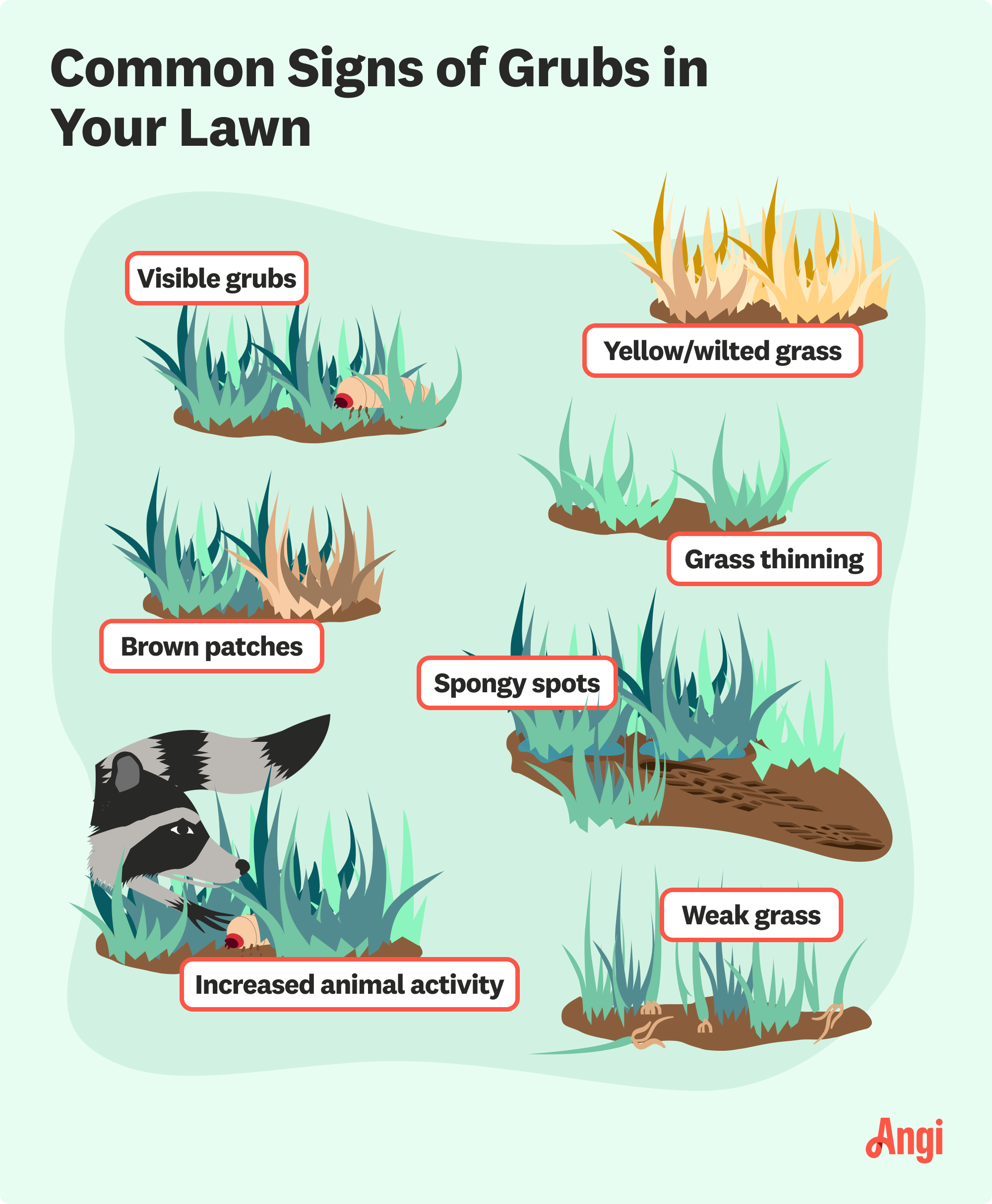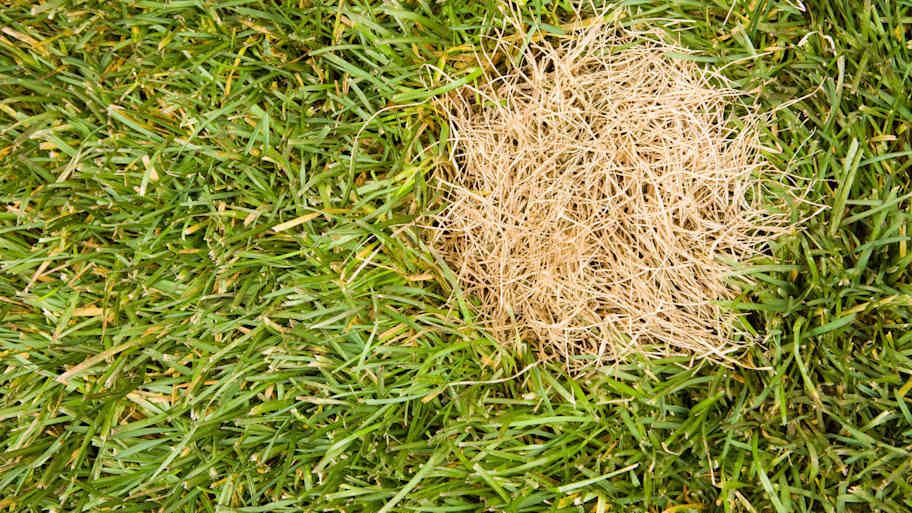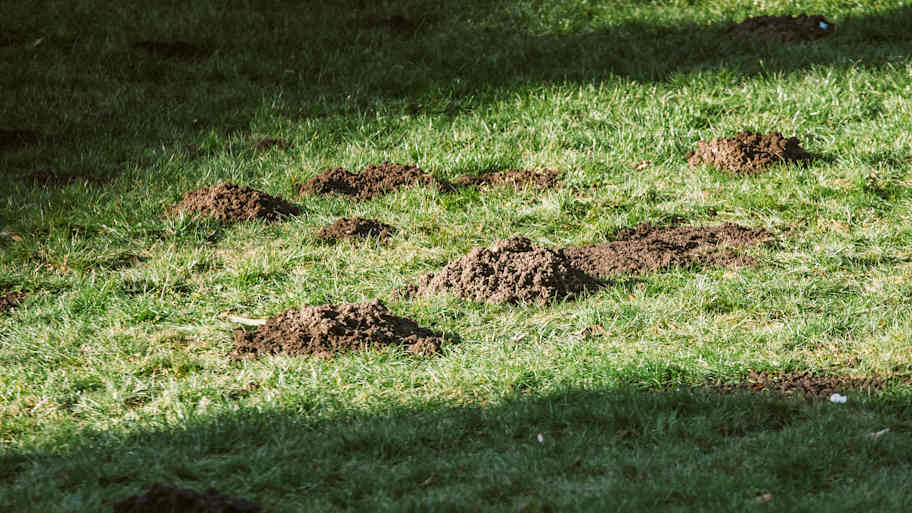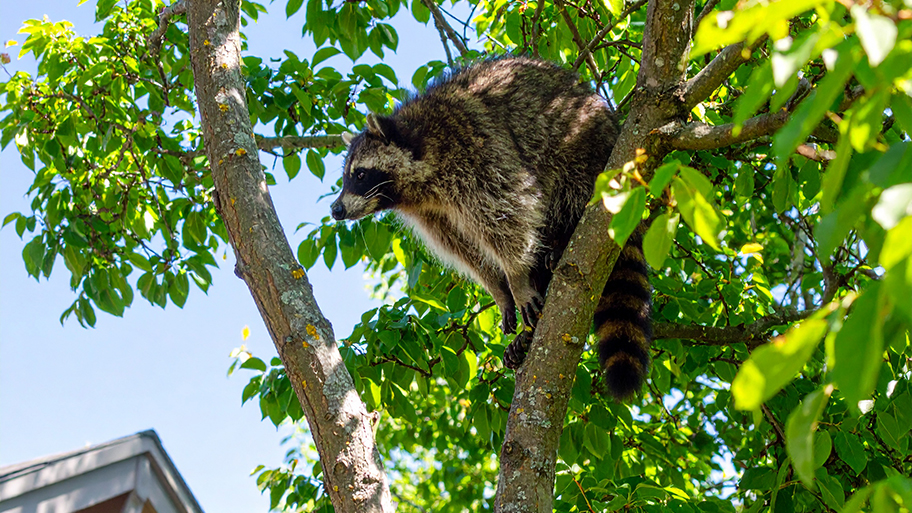
The cost to remove a groundhog can vary depending on where you live and whether you do it yourself or hire a professional. We’ll help you figure out the true cost of groundhog removal, along with strategies for humane trapping and release.
Got grubs? Here’s how you can tell


Grubs are white, C-shaped insect larvae that live in soil and eat grass roots.
Common signs of grubs in a lawn include yellow, wilted, or dead grass.
More than five grubs per square foot of soil signals an infestation.
More than 10 grubs per square foot is severe and needs pro treatment.
Pro grub control treatments cost $30 to $80 each.
Does your lawn seem a bit … grubby? Grubs are beetle larvae that can damage and even kill your healthy lawn during an infestation. Having a few grubs here and there is nothing to worry about, but how do you know when grubs have taken over and become a problem? Keep an eye out for these seven common signs of grubs in a lawn, plus follow our prevention tips to keep grubs from coming back.

Grubs may live in the soil, but they can leave behind many signs of their presence. Watch for these seven signs that grubs have taken up residence in your lawn.
One of the clearest signs of a grub problem is that you see grubs themselves in the lawn. Grubs are small, yet thick, white larvae that curl into a C shape. But having just a few grubs here and there isn’t cause for concern, and you’re not likely to see grubs on top of the lawn.
To check for a grub infestation, dig 6 to 8 inches deep into the soil to expose the grass roots. If you see over five grubs per square foot, it’s time to establish a treatment plan. However, if there are more than 10 grubs per square foot of soil, call in a pro ASAP because this constitutes a severe infestation that could permanently damage your lawn.
One of the earlier signs of grubs in a lawn is yellowed or wilted grass. Grubs begin to emerge in the early spring and will quickly begin eating your grass roots. This makes it harder for the grass to take up soil nutrients and water, leaving it looking limp and discolored, even after you increase your watering. The longer the grubs are able to feast, the more damage they can do, ultimately killing the grass completely.

Grubs can leave your lawn looking sparse while they consume the grass roots.
However, thinning grass can also point to compacted soil, watering problems, excess mowing, poor sunlight, and several other problems, so be sure to watch for the other common signs of grubs in addition to thinner grass.
Grubs eat plant roots, and by doing so, they sever the root from the blades of grass. If you suspect grubs, pull at your grass. It may come up with no roots, or it could lift up off of the soil in bigger patches. This is a clear sign of grubs in the lawn.
By eating the roots of your grass lawn, grubs kill off the grass. Dead patches in your lawn can be caused by many different issues, but if the dead patches are in unusual patterns or seem to spread quickly day by day, it could be a grub problem.
Also, grubs are most active from late summer through early fall, so dead patches that pop up this time of year are also a strong sign of grubs in your lawn.
As grubs munch away on grass roots, they leave openings in the soil where the roots had been growing. This causes the soil to feel more bouncy or sponge-like when you walk on it. If you notice spongy soil, it could mean grubs are just below the surface of your lawn.

Many different animals feed on grubs, including birds, moles, skunks, and raccoons. If you notice your backyard has become more of a wildlife hangout than usual, it could mean your lawn is a feast of grubs for these critters.
Most homeowners can manage a small grub infestation with some commercial grub removal products or natural remedies, like applying beneficial nematodes. However, if you’re dealing with more than 10 grubs per square foot of soil, you should call in a pest control pro near you to deal with the infestation before the grubs destroy your lawn.
If you’re noticing around five or six grubs per square foot of soil, you can use store-bought grub treatments to get rid of grubs. You may need to apply the grub treatment more than once during the year to kill off the existing grubs and prevent future grubs from hatching.
The most effective option, though, is to let a pro get the infestation under control. Then, you can DIY the preventative measures to keep grubs from coming back to your lawn.
After you get rid of grubs, it’s important to add some preventative measures to your lawn care maintenance checklist to keep them from returning.
Apply grub control: Grub control products act as a preventative to kill grubs before they hatch in the summer.
Maintain your lawn: Regular lawn care can keep grubs at bay. Mow frequently, but don’t cut grass too short for better root growth. Also, don’t overwater your lawn, which can attract beetles to lay their eggs.
Dethatch: Thatch is a buildup that can occur around the base of grass and offers an ideal environment for grubs to thrive. Dethatch at least once per year.
Overseed: Overseed your lawn by applying more grass seed on your existing lawn. This creates a denser, healthier lawn that’s better prepared to withstand stress or damage and helps boost recovery after grub treatment.
Grub control treatments cost $30 to $80 each, and you’ll need to apply them twice per year. If grubs also attracted unwelcome wildlife, like moles or skunks, to your yard, you’ll need to pay for animal removal, too. Animal removal costs $191 to $612 on average.
From average costs to expert advice, get all the answers you need to get your job done.

The cost to remove a groundhog can vary depending on where you live and whether you do it yourself or hire a professional. We’ll help you figure out the true cost of groundhog removal, along with strategies for humane trapping and release.

Raccoons on your property can cause a lot of damage to your home and yard. This guide breaks down raccoon removal costs so you can budget accordingly.

While moles eat termites, ants, and more, they can still be a nuisance. Learn yard mole removal costs, including humane options to decide what’s right for you.

Learn the best bait for iguana traps to help you capture and remove nuisance individuals causing damage in your yard.

Tired of raccoons raiding your garbage can or taking up residence in your attic or crawlspace? Check out this list of the best raccoon baits to find the foods that will help you trap these pesky creatures so you can relocate them.

If you're stumped about what animal is digging holes in your yard, use this guide to identify the signs of different species and stop them from causing damage.